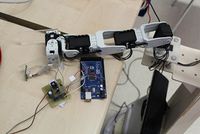Difference between revisions of "MYRAbot's arm control (bioloid+arduino)"
(→Creating a package for our programs) |
(→First program (To whole power)) |
||
| Line 86: | Line 86: | ||
</syntaxhighlight> | </syntaxhighlight> | ||
| + | We must add to the file "CMakeLists.txt" the lines indicated below in order to compile the program and send to [http://www.arduino.cc arduino] board: | ||
| + | <syntaxhighlight lang=cmake>set(FIRMWARE_NAME potencia) | ||
| − | < | + | set(${FIRMWARE_NAME}_BOARD MODELO_NUESTRA_PLACA) # Modelo placa arduino |
| + | set(${FIRMWARE_NAME}_SRCS src/potencia.cpp ) | ||
| + | set(${FIRMWARE_NAME}_PORT /dev/ttyACM0) # Puerto serie de subida | ||
| + | generate_ros_firmware(${FIRMWARE_NAME})</syntaxhighlight> | ||
| − | |||
| − | + | <!-- | |
| − | < | ||
| − | |||
| − | |||
| − | |||
| − | |||
| − | |||
| − | |||
| − | |||
| − | |||
| − | |||
| − | |||
| − | |||
| − | |||
| − | |||
| − | |||
| − | |||
| − | |||
| − | |||
| − | |||
| − | |||
| − | |||
| − | |||
| − | |||
| − | |||
| − | |||
| − | |||
| − | |||
| − | |||
| − | |||
| − | |||
| − | |||
| − | |||
| − | |||
| − | |||
| − | |||
| − | |||
| − | |||
| − | |||
Donde se indica el nombre del programa, tipo de placa [http://www.arduino.cc arduino] (uno, atmega328 o mega2560), nombre y ubicación del archivo y puerto serie del PC empleado para la comunicación con la placa. Deberemos ejecutar los siguientes comandos en un terminal: | Donde se indica el nombre del programa, tipo de placa [http://www.arduino.cc arduino] (uno, atmega328 o mega2560), nombre y ubicación del archivo y puerto serie del PC empleado para la comunicación con la placa. Deberemos ejecutar los siguientes comandos en un terminal: | ||
Revision as of 17:24, 24 December 2013
Contents
Bioloid arm
The arm that we will use is that Carlos Rodríguez Hernández developed in the project MYRA Robot: Hardware Update . The main components are:

- Arduino mega 2560 board.
- 74LS241 chip (tree-state Buffer).
- Voltage regulator circuit.
- 5 serial servo motors Dynamixel AX-12A.
- Mounting components of Bioloid kit.
- Parts made for the gripper and to fix to MYRAbot.
Arduino IDE and rosserial
For the communication among arduino and ROS, we install arduino IDE and rosserial (package de ROS which include the package rosserial_arduino with the libraries for arduino. We will start to installing arduino IDE, for this, we will execute the next commands in a terminal:
sudo apt-get update
sudo apt-get install arduino arduino-coreWhen the installation of arduino software ends, we will install the ROS package. For this, we will execute the next command in a terminal:
sudo apt-get install ros-ROS_DISTRO-rosserialWhen we will have installed arduino IDE and the stack rosserial, we must copy the libraries for the package rosserial_arduino to the sketchbook of arduino. For this, we will execute the next commands in a terminal:
roscd rosserial_arduino/libraries
cp -r ros_lib /home/”SESSION_NAME”/sketchbook/libraries/ros_libCreating a package for our programs
Previously, we must have created a workspace for our ROS distribution. We will create a package in order to compile and send our programs to arduino board. We will make a package named "arduino_fer" with the the necessary dependences for our programs, for this, we will execute the next commands in a terminal:
cd ~/ros_workspace
roscreate-pkg arduino_fer rosserial_arduino std_msgsWe must change the content of the file "CMakeLists.txt" of our package for the next lines:
cmake_minimum_required(VERSION 2.4.6)
include($ENV{ROS_ROOT}/core/rosbuild/rosbuild.cmake)
rosbuild_find_ros_package(rosserial_arduino)
include(${rosserial_arduino_PACKAGE_PATH}/cmake_scripts/rosserial.cmake)
We will execute the next commands in a terminal to finalize the creation of the package:
roscd arduino_fer
cmake .First program (To whole power)
We will make the first program that publishes a topic named "cifra" and subscribe a topic named "resultado". When we publish a number in the topic "cifra" the program multiplies the number by itself and publishes the result in the topic "resultado". The code of the program is shown below:
#include <ros.h>
#include <std_msgs/Int16.h>
ros::NodeHandle nh;
int pot;
void potencia( const std_msgs::Int16& cifra){
::pot = cifra.data*cifra.data;
}
ros::Subscriber<std_msgs::Int16> sub("cifra", &potencia );
std_msgs::Int16 res;
ros::Publisher pub("resultado", &res);
void setup()
{
nh.initNode();
nh.subscribe(sub);
nh.advertise(pub);
}
void loop()
{
res.data = ::pot;
pub.publish( &res );
nh.spinOnce();
delay(1000);
}
We must add to the file "CMakeLists.txt" the lines indicated below in order to compile the program and send to arduino board:
set(FIRMWARE_NAME potencia)
set(${FIRMWARE_NAME}_BOARD MODELO_NUESTRA_PLACA) # Modelo placa arduino
set(${FIRMWARE_NAME}_SRCS src/potencia.cpp )
set(${FIRMWARE_NAME}_PORT /dev/ttyACM0) # Puerto serie de subida
generate_ros_firmware(${FIRMWARE_NAME})